A request that this article title be changed is under discussion. Please do not move this article until the discussion is closed. |
Yufka (Turkish : thin, thin dough) may refer to:
A request that this article title be changed is under discussion. Please do not move this article until the discussion is closed. |
Yufka (Turkish : thin, thin dough) may refer to:

Turkish cuisine is largely the heritage of Ottoman cuisine, which can be described as a fusion and refinement of Mediterranean, Balkan, Middle Eastern, Central Asian, Eastern European and Armenian cuisines. Turkish cuisine has in turn influenced those and other neighbouring cuisines, including those of Southeast Europe (Balkans), Central Europe, and Western Europe. The Ottomans fused various culinary traditions of their realm with influences from Mesopotamian cuisine, Greek cuisine, Levantine cuisine, Egyptian cuisine, Balkan cuisine, along with traditional Turkic elements from Central Asia, creating a vast array of specialities.

A Danish pastry, sometimes shortened to just Danish, is a multilayered, laminated sweet pastry in the viennoiserie tradition. The concept was brought to Denmark by Austrian bakers, and has since developed into a Danish specialty. Like other viennoiserie pastries, such as croissants, it is a variant of puff pastry made of laminated yeast-leavened dough that creates a layered texture.

Dough is a thick, malleable, sometimes elastic paste made out of any grains, leguminous or chestnut crops. Dough is typically made by mixing flour with a small amount of water and/or other liquid, and sometimes includes yeast or other leavening agents as well as other ingredients such as various fats or flavorings.

Noodles are an essential ingredient and staple in Chinese cuisine. Chinese noodles vary widely according to the region of production, ingredients, shape or width, and manner of preparation. They are an important part of most regional cuisines within China, and other countries with sizable overseas Chinese populations.

Lavash is a thin flatbread usually leavened, traditionally baked in a tandoor (tonir) or on a sajj, and common to the cuisines of South Caucasus, Western Asia, and the areas surrounding the Caspian Sea. Lavash is one of the most widespread types of bread in Armenia, Azerbaijan, Iran and Turkey. The traditional recipe can be adapted to the modern kitchen by using a griddle or wok instead of the tonir.

Popiah is a Fujianese/Teochew-style fresh spring roll. Popiah is often eaten in the Fujian province of China and its neighbouring Chaoshan and in Taiwan, during the Qingming Festival. The origin of popiah dates back to the 17th century.
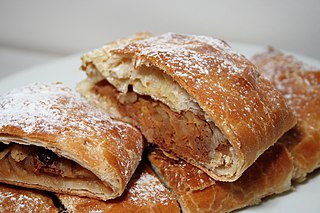
Apple strudel is a traditional Viennese strudel, a popular pastry in Austria, Bavaria, Czech Republic, Northern Italy and in many other countries in Europe that once belonged to the Austro-Hungarian Empire (1867–1918).

Filo or phyllo is a very thin unleavened dough used for making pastries such as baklava and börek in Middle Eastern and Balkan cuisines. Filo-based pastries are made by layering many sheets of filo brushed with oil or butter; the pastry is then baked.

A strudel is a type of layered pastry with a filling that is usually sweet. It became popular in the 18th century throughout the Habsburg Empire. Strudel is part of Austrian cuisine but is also common in other Central European cuisines. In Italy it has PAT recognition, which classifies it as a traditional agri-food product.

Börek is a family of baked filled pastries made of a thin flaky dough such as phyllo or yufka. Common fillings are made with meat, cheese, leafy greens or potatoes. Börek are found in the cuisines of the Balkans, the South Caucasus, the Levant, Central Asia, and some Eastern and Central European countries. A börek may be prepared in a large pan and cut into portions after baking, or as individual pastries. Börek is occasionally sprinkled with sesame or nigella seeds.

Gözleme is a savory Turkish stuffed flatbread. The dough is usually unleavened, and made only with flour, salt and water, but gözleme can be made from yeast dough as well. It is similar to bazlama, but is lightly brushed with butter or oil, whereas bazlama is prepared without fat. The dough is rolled thin, then filled with various toppings, sealed, and cooked over a griddle. Gözleme may sometimes be made from prepackaged hand-rolled leaves of yufka dough.
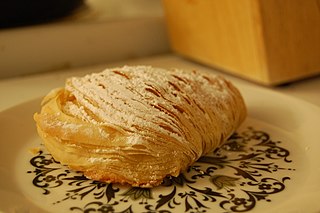
A sfogliatella, is a shell-shaped filled Italian pastry native to Campania. Sfogliatella means "small, thin leaf/layer", as the pastry's texture resembles stacked leaves.
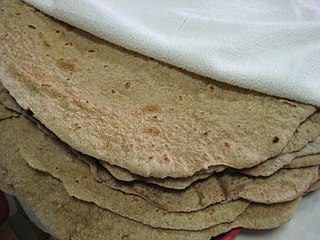
Markook bread, also known as khubz ruqaq, shrak, khubz rqeeq, mashrooh, and saj bread, is a kind of Middle Eastern unleavened flatbread common in the Levant and the Arabian peninsula. It is baked on a convex metal griddle or in a tannour.

Tunnbröd is the Swedish version of flatbread and properly belongs to northern Swedish cuisine where housewives share a common bakery to produce it. Tunnbröd can be soft or crisp, and comes in many variants depending on choice of grain, leavening agent and rolling pin. The dough is made from any combination of wheat, barley and rye; the leavening agent can be both yeast and ammonium carbonate.

A rolling pin is a cylindrical food preparation utensil used to shape and flatten dough. Two styles of rolling pin are found: rollers and rods. Roller types consists of a thick cylinder with small handles at each end; rod type rolling pins are usually thin tapered batons. Rolling pins of different styles and materials offer varying advantages, as they are used for different tasks in cooking and baking.
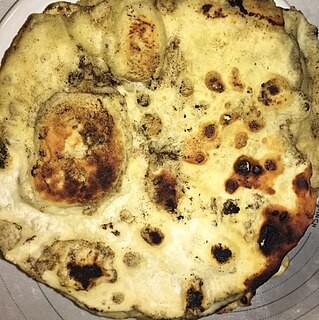
Laffa, also known as lafa or Iraqi pita, is a large, thin flatbread in Israeli cuisine, of Iraqi origin. It is cooked in a tannur (tandoor) or taboon oven. Laffa does not form a pocket like a Levantine pita; it is most often used to wrap sandwiches such as falafel and shawarma, to dip in hummus, matbucha and other dips, or with shakshouka, and other dishes. It is also the traditional bread used in sabich, an Israeli eggplant sandwich. It is similar to, or indistinguishable from, many tandoor breads found in Asia including naan and the traditional Palestinian taboon bread.
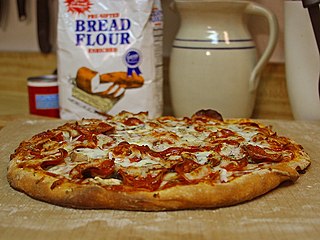
Numerous regional variations of pizza in the United States have been developed, with many bearing only a casual resemblance to the Italian original. Pizza became most popular in America after soldiers stationed in Italy returned from World War II.

Roti canai, or roti chenai, also known as roti cane (/tʃane/) and roti prata, is an Indian-influenced flatbread dish found in several countries in Southeast Asia, including Brunei, Indonesia, Malaysia and Singapore. It is usually served with dal or other types of curry, but can also be cooked in a range of sweet or savoury variations made with a variety of ingredients such as meat, egg, or cheese. Roti canai is a popular breakfast and snack dish in Malaysia, and one of the most famous examples of Malaysian Indian cuisine. It is said that the dish was brought over from India by Indian Muslims, also known as "Mamaks" in Malaysia, and is served in Mamak stalls located in both rural and urban Malaysia.
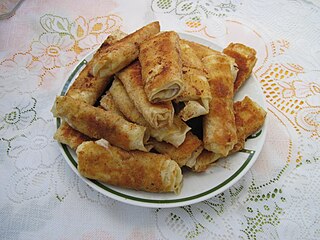
Paçanga böreği is a type of börek made with yufka filled with cheese, pastirma, tomato, parsley and pepper. Each material is chopped into thin or small pieces, and rolled in the dough as in sigara böreği, but larger. The pastries are fried and served hot.
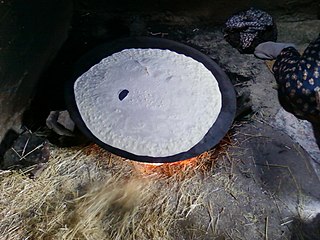
Saj bread or yufka is a very thin, large (60 cm [24 in]) unleavened flatbread in Turkish and Arab cuisine baked on a convex metal griddle, a saj.